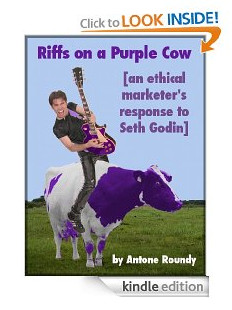When you purchase through links on our site, we may earn an affiliate commission (details)
Marketing Lessons from the Rodney King Incident
by Antone Roundy | 1 Comment | Copywriting, Marketing
When I read that today is the 20th anniversary of the Rodney King beating, it brought back a flood of images. First, of course, was the video of the beating on the news.
I lived in San Francisco at the time, so I also remember seeing the broken and boarded up windows downtown after the riots sparked by the verdict. I'm sure it was nothing compared to the damage in LA, but it still made a lasting impression.
I lived half way up Nob Hill, so I wasn't in the middle of the rioting. But I remember watching from my 5th floor window and seeing someone throwing a garbage can at a car.
My sister in law, who lived in Oakland at the time, was in San Francisco when the riots started. A friend of hers -- a large black woman -- grabbed her and ushered her to safety in the BART station so she could get home.
I also remember the inspiring image of a truck driver named Reginald Denny. During the riots, he was pulled from his truck and nearly killed. Later, he forgave the man who'd thrown a brick at his head. Nearly 20 years later, I don't need to read the news stories to remember his name with honor.
Ever since I started blogging daily last September, it seems like marketing lessons pop out at me everywhere. And this story is no exception. Let's start with a question:
Do you think the police officers should have been convicted?
I'm not going to answer that question, because what I know is that I don't know. If you saw the video, you may think it's impossible to be on the fence, so let me explain.
Most of the footage that was shown on the news showed King on the ground being tasered and brutally beaten.
But I remember one time (amazingly, one time only) seeing an extended video clip where King was fighting back. I don't know how long that lasted, or whether there was more video like that. But I can tell you one thing -- if I'd been one of the officers, I wouldn't have been able to rest easy until I was confident he wasn't going to come at me again.
Was the beating justified? In my opinion, it looked excessive. But I can't claim to know for sure.
So, what's the marketing lesson?
First, why do you think the news almost never showed King fighting back?
Maybe they had limited time, and couldn't show the whole clip.
Yeah, right. This was the big story at the time. They could have spent half the broadcast on it.
Maybe they didn't think that part of the video was important.
Uh, huh.
Seems to me, it was all about marketing. "Man gets in fight with police and loses" isn't nearly as compelling a story as "man gets brutally beaten by police." Even if the full video would have shown the beating to be excessive, anything that made the incident look more balanced would likely have reduced interest in the story.
Pathetic. But I can't explain it any other way.
Marketing lesson #1 could be stated either of two ways. The evil way is, "tell a lopsided story, leaving out anything that might convince the customer not to buy."
That may very well work with some people. But you're going to get more refunds from those who are surprised by the things you didn't tell them. And you're also going to lose sales to people who simply don't believe your suspiciously rosy story. Admitting your product's weaknesses has been proven to increase trust in your claims about your product's strengths.
The non-evil way to state the lesson is, "leave out the irrelevant, boring stuff." I'm not saying the video that was left out was boring or irrelevant. Just that it wasn't part of the story the news was trying to sell.
Does your sales letter drone on about features and benefits that matter to you, but not to the customer? If so, take a deep breath, to let it go, and cut, cut, cut.
Marketing lesson #2 is less controversial:
The customer doesn't know what nobody's told 'em.
Most people probably never saw the extended video clip. Or if they only saw it once, they may have forgotten about it. If the whole clip had run every time, public opinion probably would have shifted, at least a little.
What are you leaving out of your marketing message? What are you assuming everyone knows? What's a boring detail to you that your customer needs to hear?
It can be tricky striking the right balance between too little information and too much. How can you make the details accessible without overdoing it and turning off those who already know them?
One key is to make your copy scannable. Use visual cues like bold subheads to tell people what each section of your sales letter (or blog post) is about. That way, people can skip the stuff that's not relevant to them.
You might embed videos in your sales letters discussing the less universally interesting details. Those who need that information can stop and watch them, and those who don't can skip them.
Marketing lesson #3:
Be memorable.
20 years from now, you won't remember what you had for breakfast yesterday (unless it sent you to the hospital with food poisoning). We remember things that are surprising, dramatic, or, like Reginald Denny, noble. How do you think it'd impact your business if potential customers remembered you as noble? That's better than simply being unusual.





March 3rd, 2011 at 1:08 pm
Cruel as your article may read to those not in the business of providing the searchers with a reward for their click, you must provide them what they seek even if it is subliminal. This may prompt this old saying to be rewritten for today’s web experience: “Never watch sausages or web designers controlling the visitors experience on their siteâ€.